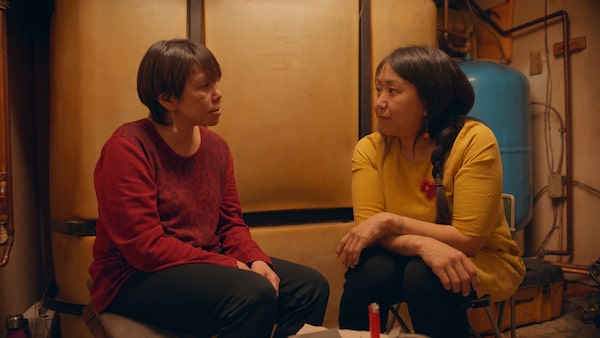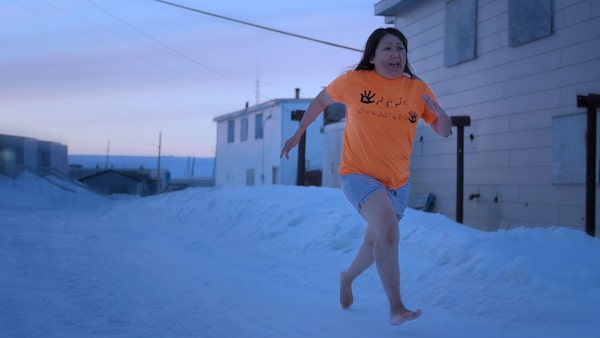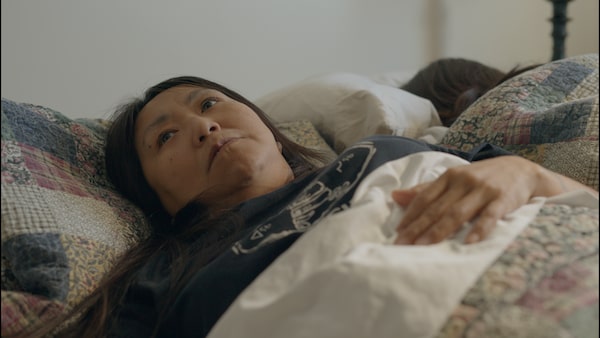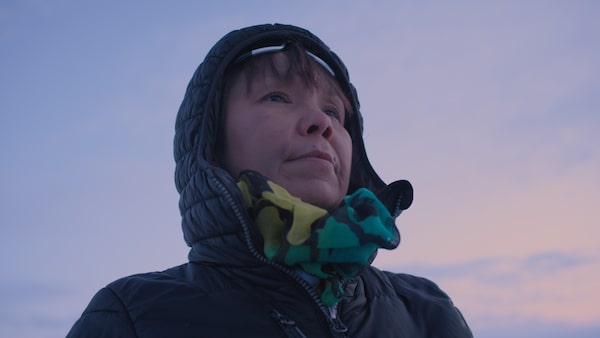
Tautuktavuk (What We See) was directed by Carol Kunnuk, left, and Lucy Tulugarjuk.KINGULLIIT PRODUCTIONS AND ISUMA PRODUCTIONS/Supplied
It doesn’t matter which parts of the verité-style film Tautuktavuk (What We See) are scripted and which aren’t. Co-directors Lucy Tulugarjuk and Carol Kunnuk have woven their experiences and those of friends and family into a documentary/fiction hybrid that doesn’t have to worry about what’s real, because it’s about what’s true: The persistence of trauma in Inuit communities. The ubiquity of abuse – sexual and physical, domestic and institutional. The grave lack of support systems in the North. The solace of community. The effort of healing.
The film premieres at the Toronto International Film Festival on Sept. 8, and will tour screens across Nunavut later this year.
Tulugarjuk and Kunnuk, cousins in real life, play sisters Uyarak and Saqpinak, who grew up in Igloolik, Nunavut. Saqpinak (like Kunnuk) still lives there, surrounded by elders and relatives. Uyarak (like Tulugarjuk) lives in Montreal, where she fled to access health services after a violent incident. Through a series of Zoom conversations that culminate in Uyarak’s trip home, it becomes clear that the sisters have things they need to say out loud, and that speaking about one’s pain is a necessary step in healing.
The co-directors are seasoned filmmakers who work with Isuma Productions, the Inuit-owned collective behind projects including Atanarjuat: The Fast Runner and One Day in the Life of Noah Piugattuk. Tulugarjuk, the executive director of Nunavut Independent Television Network (NITV), starred as the troublemaking Puja in Atanarjuat, and directed the children’s film Tia and Piujuq. Kunnuk is an actor, director and TV host (Welcome to my Qammaq). They knew Tautuktavuk’s heavy material required a delicate touch.

Lucy Tulugarjuk said she’s never run barefoot on snow from an abuser, as her character Uyarak does. But she knows women who have.KINGULLIIT PRODUCTIONS AND ISUMA PRODUCTIONS/Supplied
“Inuit culture is centred on ‘we,’ so speaking out as ‘I’ is not encouraged,” Gillian Robinson, one of the film’s screenwriters, said in an interview. “We had to uncover how the ‘I,’ who needs to speak about harm and damage, can still honour the ‘we.’ ” (The title reinforces the film’s collective vision: That “K” at the end of Tautuktavuk indicates that its point of view is plural.)
Through a collaborative writing and editing process, several wholly improvised scenes and a shoot reshaped by COVID-19 restrictions, the co-directors found a way of imparting heartbreaking information so subtly, you don’t always realize what’s being said until it echoes in your own chest.
“I wanted to bring attention to the issue of violence against Inuit women in small communities,” Tulugarjuk said in a video interview. “I know the way that fear is present.” She’s never run barefoot on snow from an abuser, as her character Uyarak does. But she knows women who have. “And I was a victim of a priest, Eric Dejaeger, from age four to six, inside those walls we show in the film.” She pauses. “I used to refuse to say his name out loud. Thanks to counselling I’ve learned to not bawl when I talk about him.”
When she was in grade seven, police officers came to Tulugarjuk’s classroom and questioned the girls about Dejaeger. “No one raised their hand, so I didn’t raise mine,” she says. “It made a lot of us uncomfortable, so none of us talked about it afterward. But I remember wondering, ‘Why are we keeping a secret to protect him?’ I started to question a lot.”
In 2015, Dejaegar was convicted of 32 counts of sexual assault in Igloolik between 1978 and 1982. (The Catholic Church had transferred him there from Alberta – where he’d previously assaulted children.) In May of this year, he was released on parole. In June, Tulugarjuk pressed new charges of her own. (The film’s credits include 1-800 help lines, and a counsellor will attend the Nunavut screenings.)

Through a collaborative writing and editing process, several wholly improvised scenes and a shoot reshaped by COVID-19 restrictions, the co-directors found a way of imparting heartbreaking information so subtly, you don’t always realize what’s being said until it echoes in your own chest.KINGULLIIT PRODUCTIONS AND ISUMA PRODUCTIONS/Supplied
“I was an angry woman,” Tulugarjuk says. “I can go on and on about systemic racism, about the government of Canada and the police. How Inuit women won’t talk about domestic abuse, because they fear Social Services will take their children. The foster care system is the new residential school.
“There’s a lack of housing in every single community in the North,” she continues. “And a health care system that offers us Tylenol instead of a physical examination. We have to go south, leave our communities, lose our language, to get help. In school they taught us Indians are savages and that Columbus discovered America and we had to accept that, though we knew about our ancestors’ sod houses and graves. Whalers, explorers, we knew they were guided by Inuit. Inuit women like my mother provided caribou clothes, a whole set of hides, in exchange for one Bible. All my life I saw injustice, and I still see it.
“But the part in the film where I say, ‘To stop the violence I have to get help, because I don’t want to pass it to my children’ – that also happened to me,” Tulugarjuk says. “Being abused is exhausting, and so is passing on that abuse. I had to learn, through counselling, that it’s okay to feel anger, but okay to then let it go. I had to learn to say, ‘Enough, this is not mine, I don’t have to carry it.’ Not a lot of Inuit have the opportunity to hear that from a counsellor. The film is a way of sharing what I learned.”

'When I did Atanarjuat I had no idea what I was getting myself into. There are more of us Inuit filmmakers now, but there need to be a lot more. Everything I do, I try to encourage people to tell their stories,' said Lucy Tulugarjuk.KINGULLIIT PRODUCTIONS AND ISUMA PRODUCTIONS/Supplied
The scenes of healing bubble like champagne – Uyarak visiting her friend Beatrice Deer (Tulugarjuk’s “role model for getting sober,” who made some of the music in the film). Deer’s daughter giving Uyarak/Tulugarjuk a real hand-poked tattoo, on camera. Visits from children and grandchildren. Uyarak sharing food with her ex-husband and his new wife, and listening to the stories of her aunt, played by the co-directors’ real aunt, the actress Madeline Ivalu (The Grizzlies). The dialogue we hear the most? “I love you.”
Tulugarjuk hopes that standing on a TIFF stage as a Inuk female director “will inspire someone in 2023, the way seeing Buffy Ste. Marie on television in 1991 blew my mind,” she says. “When I did Atanarjuat I had no idea what I was getting myself into. There are more of us Inuit filmmakers now, but there need to be a lot more. Everything I do, I try to encourage people to tell their stories.
“I hope people who see it feel an acceptance of who they are,” Tulugarjuk sums up. “I hope they feel it’s safe to ask for help. I hope it creates long-term goals for a safer environment for our future generations. I’m a little nervous to show it to my family. It’s so close to so many people. But I know it’s important to talk about it.”